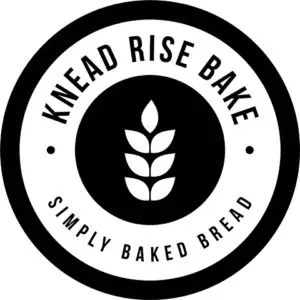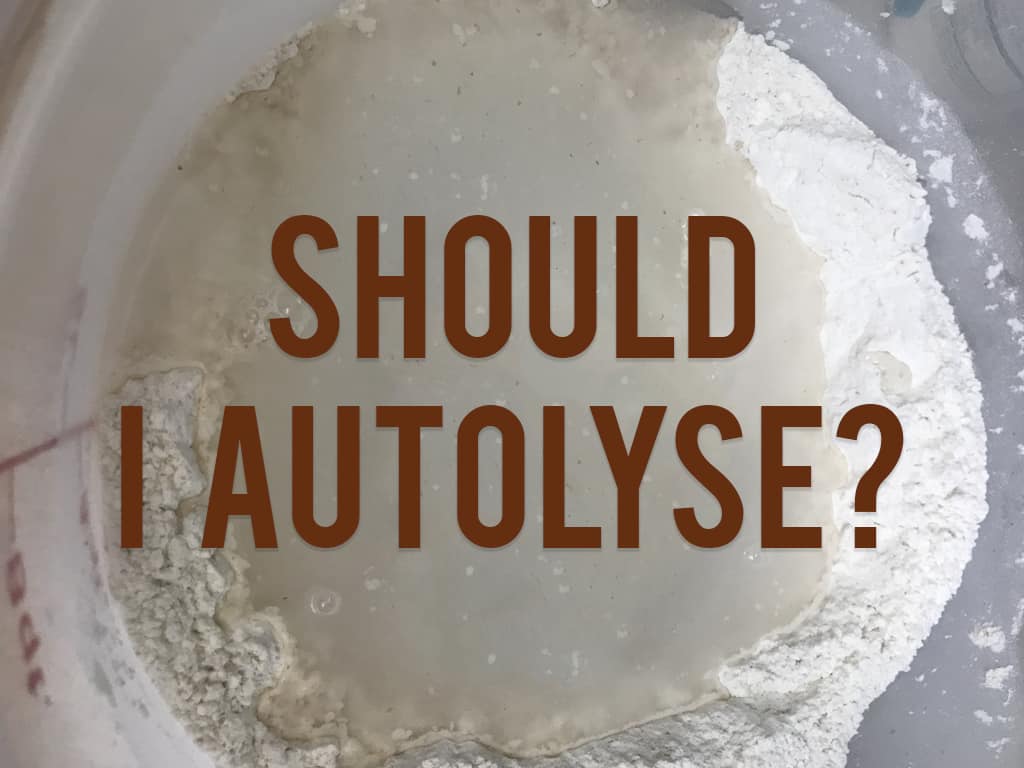The fact that this is such a common question is a bit ironic. Let me explain that for a second.
In the early days of our sourdough journey, I saw so many bakers autolyse their sourdough that it made me think I was doing something wrong by not doing it. We were making good bread, but I reasoned that maybe some of the less than perfect crumbs and crusts we were getting had something to do with not doing an autolyse.
So I went all-in on giving it a go. I tried a variety of autolyse times and hydration levels all with mixed results. I honestly felt like the only consistent thing the method added to my bread was more time.
Sure from time to time, I noticed our dough was more extensible (a $5 baking word for stretchy) and had a better crumb or crust. But, it was hit or miss. So I started doing some research on the autolyse process and I was shocked by one key aspect. It was only introduced to sourdough methods in the 1970’s! It’s just a baby!
And that’s where the irony comes in. Asking if I need to do an autolyse for soudough is kind of like asking if I need to use a microwave to boil water.
Sourdough bread, which quite literally is as old as civilization, predates the autolyse method that was recently invented in the 1970’s, by the French Scientist, Raymond Calvel. Given that fact, adding an autolyse to your sourdough process is not needed.
Thankfully unlike the chicken and the egg, this one is easy to conclude that sourdough came first and then the autolyse. But, maybe this has all been too tongue in cheek. Maybe you really just want to know if you “should” do an autolyse. For that, stick with me…
Why Autolyse?
Doing an autolyse gives dough time to better hydrate and go through a variety of transformations. I can really geek out on this one, but I’ll spare you as I’m learning to restrain myself.
But first, a word to my nerds! I’m not going to leave you completely hanging. For more on this and a whole host of super interesting bread-related nerdery, get your hands on Raymond Calvel’s book The Taste of Bread. It’s pricey! But, it is full of a host of great content that will absolutely make you a more confident baker.
I’ll just say that it has to do with hydration levels, enzyme activation, and how that impacts protein/gluten development. The end result is a softer more conditioned dough. The baking term used is extensible, adding a nice stretch with good structure.
But, here is the major caveat! Unless you are using more “artisan bakery” type flour, you likely will not see a major difference.
Let me unpack that. Many store-bought flours are finely ground and often times even conditioned with things like ascorbic acid. This lends itself to being better for hydration and extensibility right out of the box (bag). For these types of flours, you probably will only see minor differences if anything at all.
However, when using stone ground, whole wheat, or hard flour varieties you will likely see a pretty significant improvement from using an autolyse. This has to do with what I mentioned above with hydration and enzymes.
Think of the autolyse like a conditioner for your hair. As gross as hair and bread are in the same sentence, please stick with me here.
I typically don’t use conditioner in my hair. I tend to keep my hair short and don’t see much benefit from using it. Sure it’s softer when I do sneak some of Carrie’s but, it’s not life-changing.
But, if I’ve been spending a lot of time in the pool, you better believe I’ll use conditioner each time I swim. Beyond that, I’ll see a major difference in how soft my hair is afterward. Depending on how much I’ve been swimming, I might even do a couple of rounds of conditioner.
My point here is that the harder my hair is, the more I need to condition it. The same is true for flour.
The harder/thirstier the grain (usually has to do with the variety of flour or how fine it was ground) the more soaking and hydration it will need. The autolyse is like doubling up on your conditioner. But if you’re using white bread flour that you pulled off the shelf, then you likely don’t need to do it.
For most baking around here, we use the plain white stuff from King Arthur (their bread or all purpose). Which means we only see minor improvements when doing an autolyse.
However, you might just want to give it a try to see how it works out for your flour, even if it’s just plain white. Or, maybe you’re using whole wheat which absolutely needs some extra “conditioning” either by using extra water or an autolyse. In that case, it’s a matter of needing to know how long you should autolyse.
How Long Should You Autolyse?
If you’ve decided you want to give it a try with your white flour, or you “need” to because you’ll be using whole wheat then you will want to keep some things in mind.
- The finer the flour, in general, the less you need to let it soak. 15-20 minutes is sufficient.
- Likewise, the more coarse your flour is the more time it needs. 45 minutes to 1 hour should be fine for most store-bought coarse flours.
- If you are using a high portion of whole wheat or coarse ground flour then you will want an extended time. This might need upwards of 3 hours or more. Just test it out a bit.
- No amount of time will overcome weak protein content. If you’re using a flour that doesn’t have 10% or higher protein content, you might want to let it go upwards of an hour to try to improve it. But you might just be spinning your wheels and wasting some time. You’d see far better results by starting with bread flour (that is around 12% protein) and not performing an autolyse. You’d at least save yourself some time this way.
How long you autolyse has to do with the ingredients you’re using more than anything. I can’t give you an exact number, as the options are endless, but I’ll just say follow your recipe to the letter (including the ingredients) for the best results.
It is important to remember that a recipe is developed with the ingredients in mind. How long dough bulks and proofs has as much to do with the amount of yeast/starter as it does the temperature. Likewise, hydration levels and autolyse times are set because of the type of flour being used.
The one area that has wiggle room, I’d argue, is swapping all-purpose for bread flour. Those are generally pretty safe to swap without any further changes needed for the rest of your recipe. But take care to note the protein content. If the bread flour you usually use is 12-14%, then you’ll see major differences if you use an all-purpose flour of 8%.
For more on that, you can check out our article where we discuss the ins and outs of AP and bread flour: https://kneadrisebake.com/what-is-the-difference-between-bread-flour-and-all-purpose-flour/
Should You Add Salt?
One of the common questions associated with the autolyse method has to do with adding salt. There are a variety of individuals who share that they do add salt to their autolyse.
However! The practice, as expressed by the inventor of the method, involves just water and flour being mixed lightly and soaked. So, if I were a purist I’d say absolutely not! Don’t add salt. Or if you do, don’t call it an autolyse!
But I’m not a purist, and plenty of bakers express that some salt might help improve an autolyse.
However, salt can muck things up really quickly. Ultimately that means you would simply be adding time to your process for nothing, just because you added salt. Most suggest not doing it unless you’re prepared to experiment quite a bit. And remember that the levels of salt will vary by the type of flour and hydration levels. Which is why you would need to experiment to know how much, or just avoid it as Calvel suggests. 🙂
But What Does It Even Do For Bread?
At this point, you might be begging me to answer what this stretchy dough actually does for your final loaf of bread.
And that is the easiest part of this entire post! It makes everything better. Seriously, all the things we love about bread gets better. Especially the crust, crumb, flavor, and oven spring (rise).
But remember, how much better depends on what you’re working with. Just decide if it’s worth the time or not. For us, it’s a definite sometimes maybe. 🙂
Told you it was simple!

